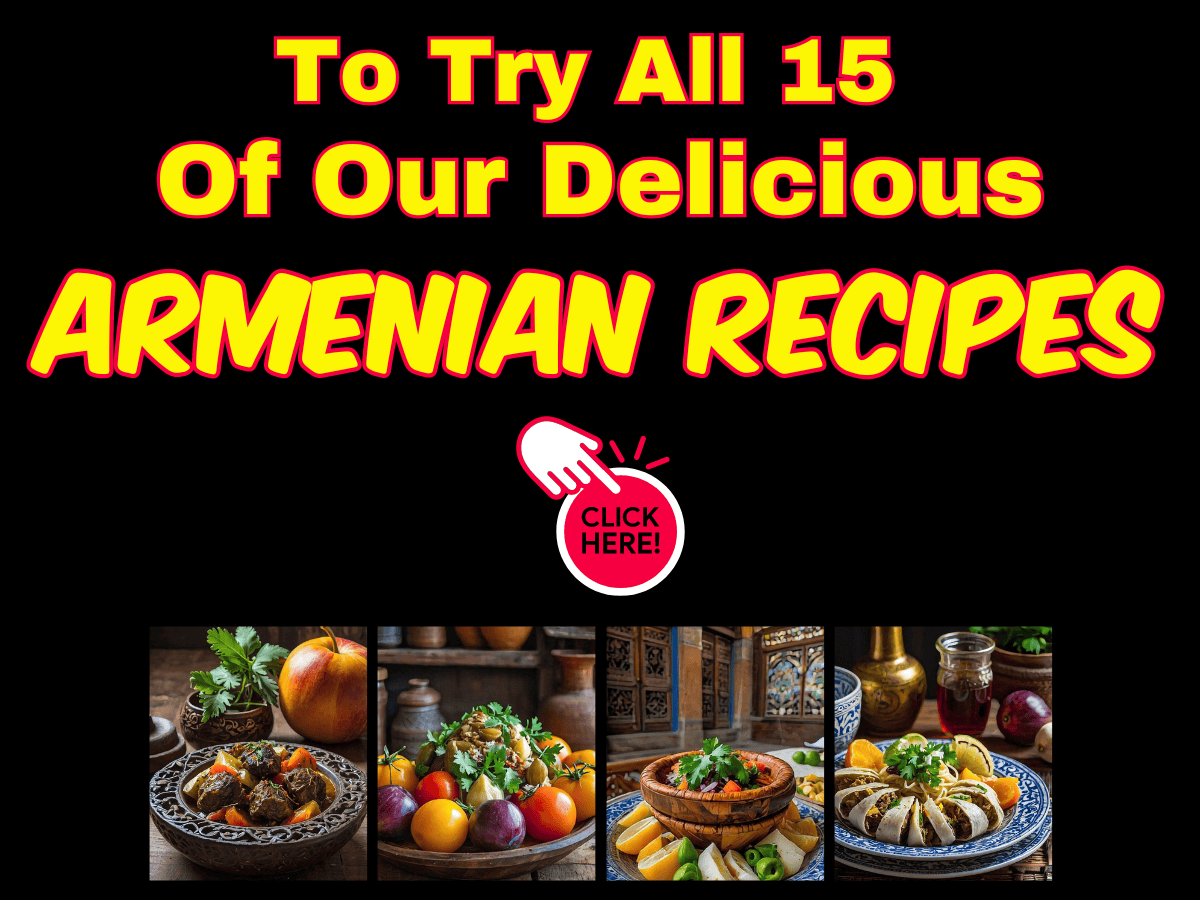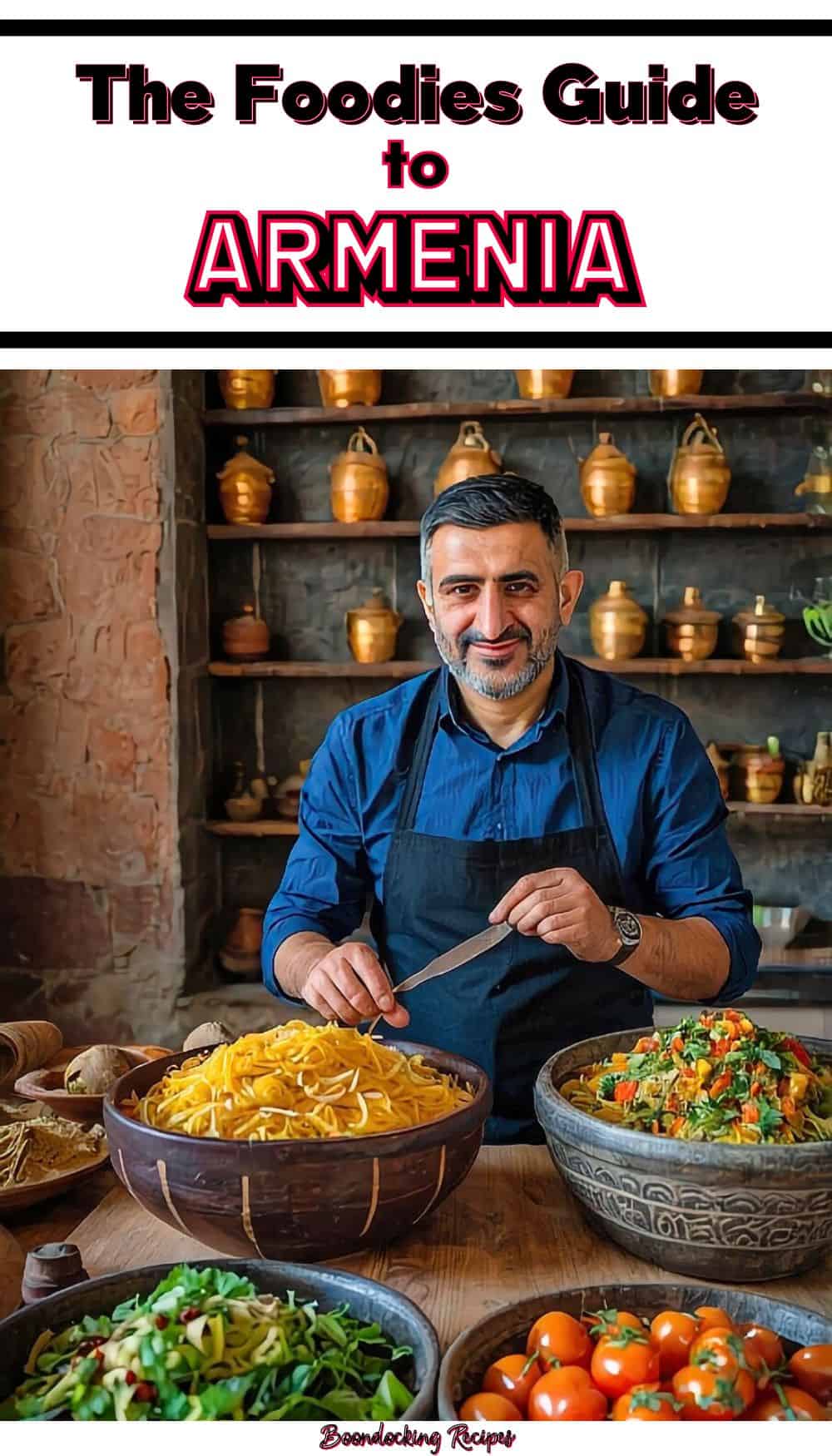Armenia Foodie Travel
Travel. When I launched on my foodie travel journey through Armenia, I was captivated not just by its breathtaking landscapes but also by its rich culinary tapestry. Each meal, each dish, told me a story of the country’s history and culture. If you’re a lover of foodie travel like me, you’re in for a treat! In this guide,
I’ll take you through Armenia’s vibrant food scene, sharing tempting dishes and charming eateries along the way. Ready to indulge your taste buds in an unforgettable Armenian foodie travel adventure? Let’s dive in! This quick start section will take you through the basic information you will need for an Armenian foodie adventure. For everything you need to know read on after this quick guide to the main article. We also hope you will visit our post 25 Easy Authentic Armenian Recipes.
History of the Country Name
The Meaning Behind ‘Armenia’
The name Armenia derives from the ancient Kingdom of Ararat, which is steeped in mythology and historical significance. Locals often refer to their homeland as ‘Hayastan,’ stemming from Hayk, an ancient figure, symbolizing national pride.
Historical Influences
Throughout the ages, Armenia has been influenced by various empires, including the Persians, Romans, and Ottomans. This diverse history is reflected in its food culture, making the country’s culinary offerings both unique and telling of its past.
Armenia Foodie Today
Armenia is now celebrated for its resilience and rich cultural heritage. This identity is woven into the fabric of the nation’s food scene, where traditional recipes thrive alongside modern twists.
Location
Geographical Wonders
Nestled in the South Caucasus, Armenia is a landlocked nation bordered by Turkey, Georgia, and Azerbaijan. Its stunning mountain ranges and valleys create an ideal backdrop for a rich agricultural landscape.
City and Countryside
From the bustling capital, Yerevan, to the tranquil villages, each region offers its own specialties. The contrast between urban eateries and rural taverns enriches the culinary experience.
Climate’s Influence
Armenia’s climate, characterized by hot summers and cold winters, helps shape its food culture. Seasonal ingredients play a vital role in the authenticity of traditional dishes.
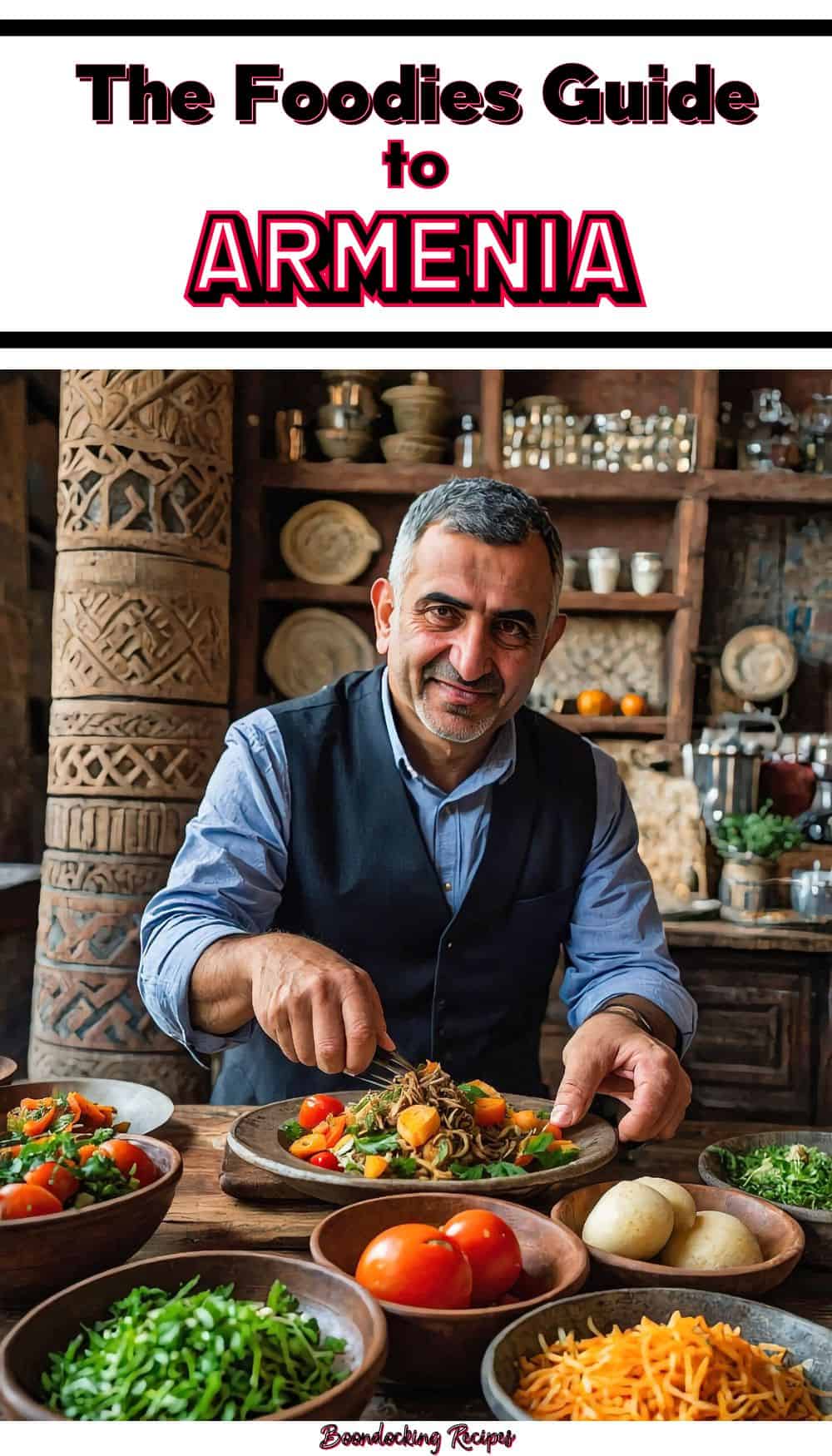
Brief History
Ancient Origins
Armenia is one of the oldest countries in the world, with roots tracing back to the 6th century BC. It was the first nation to adopt Christianity as a state religion, which has remarkably influenced its cuisine.
Industrial Changes
Post-Soviet Armenia saw significant shifts in lifestyle and food production, introducing new flavors while cherishing age-old recipes.
Modern-Day Revival
Today, Armenian cuisine is experiencing a renaissance, with chefs bringing a mix of tradition and innovation to the table.
 Culture
Culture
Hospitality and Gathering
Armenians take pride in their hospitality, often inviting you in for a meal that feels like a warm embrace. Sharing food is more than just sustenance; it fosters community and connection.
Festivals and Celebrations
Food is central to Armenian festivities, like the Vardavar summer festival, featuring delicious homemade dishes that change with the seasons.
Rituals and Traditions
Many recipes are passed down through generations, steeped in ritual—a reflection of familial love and cultural pride.
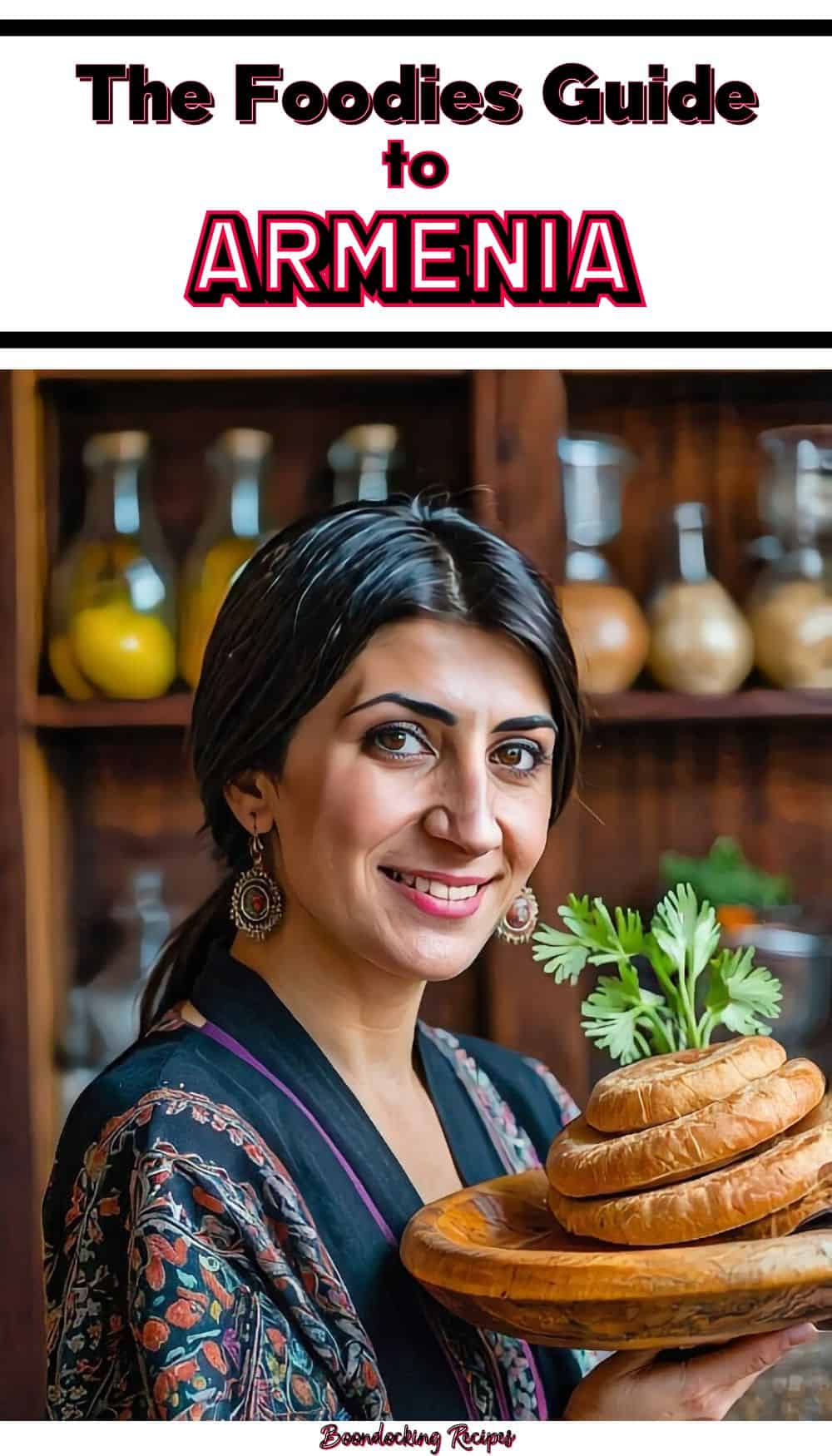
Foodie Influences and Roots
Regional Influences
Armenian cuisine is a delightful amalgamation of Middle Eastern, Mediterranean, and Eastern European influences, giving it depth and variety.
Agriculture’s Role
Local produce, particularly fruits and vegetables like eggplants and tomatoes, is key in Armenian dishes, enhancing both flavor and nutrition.
Preservation Techniques
Pickling and sun-drying are traditional methods that reflect a respect for ingredients and seasonal bounty, ensuring that flavors are maximized.
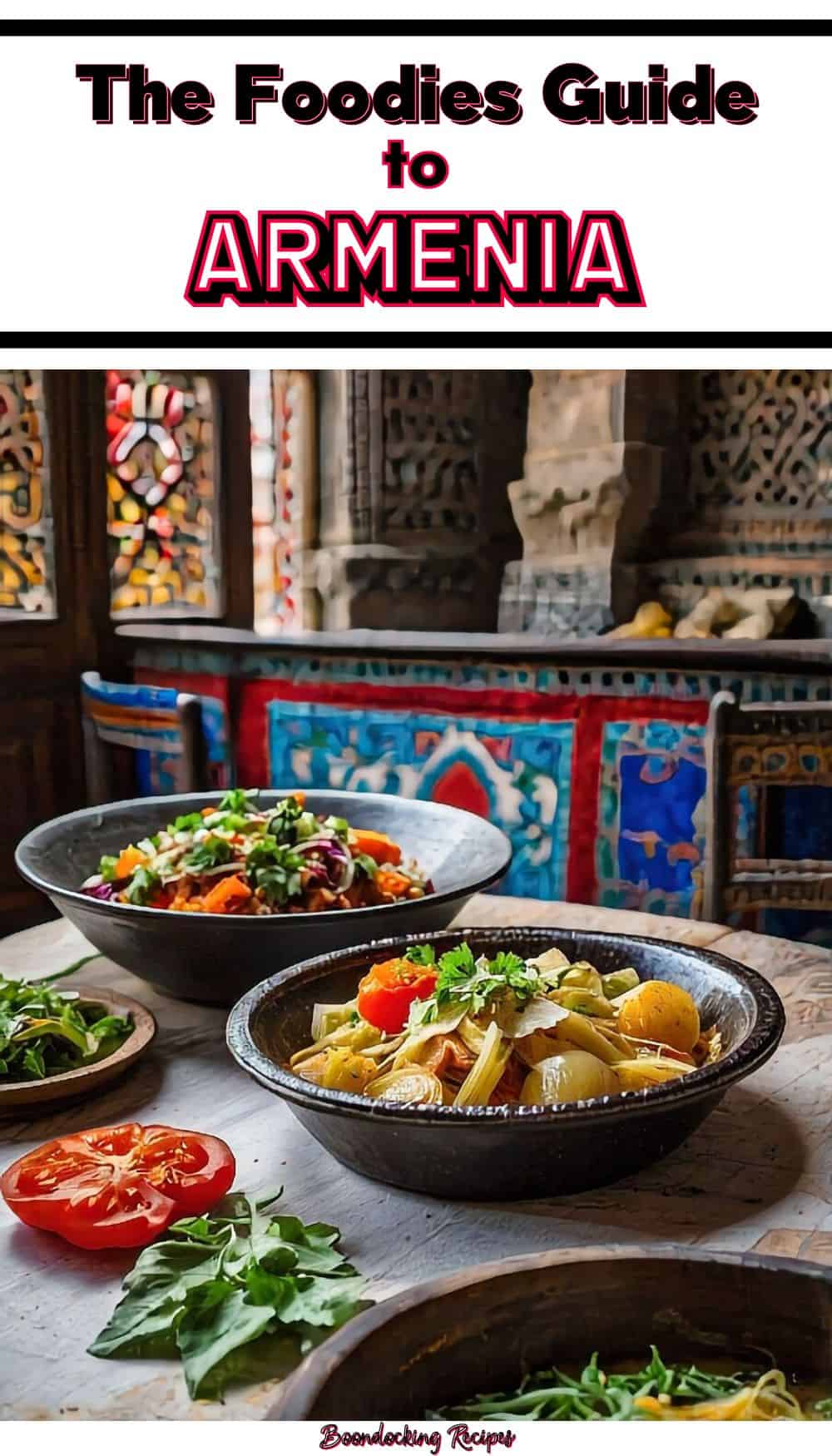 Cuisine and Cooking Methods
Cuisine and Cooking Methods
Traditional Cooking Techniques
Armenian cooking often involves grilling, roasting, and slow-cooking, allowing flavors to meld beautifully. The use of clay pots is common, providing a unique taste to dishes.
Essential Cooking Equipment
Traditional utensils like the ‘tonir’ (a clay oven) are prevalent in Armenian kitchens, highlighting the importance of cooking methods in flavor development.
Modern Culinary Trends
Chefs are increasingly fusing international techniques with classic recipes, appealing to both locals and tourists eager to experience Armenian cuisine’s evolution.
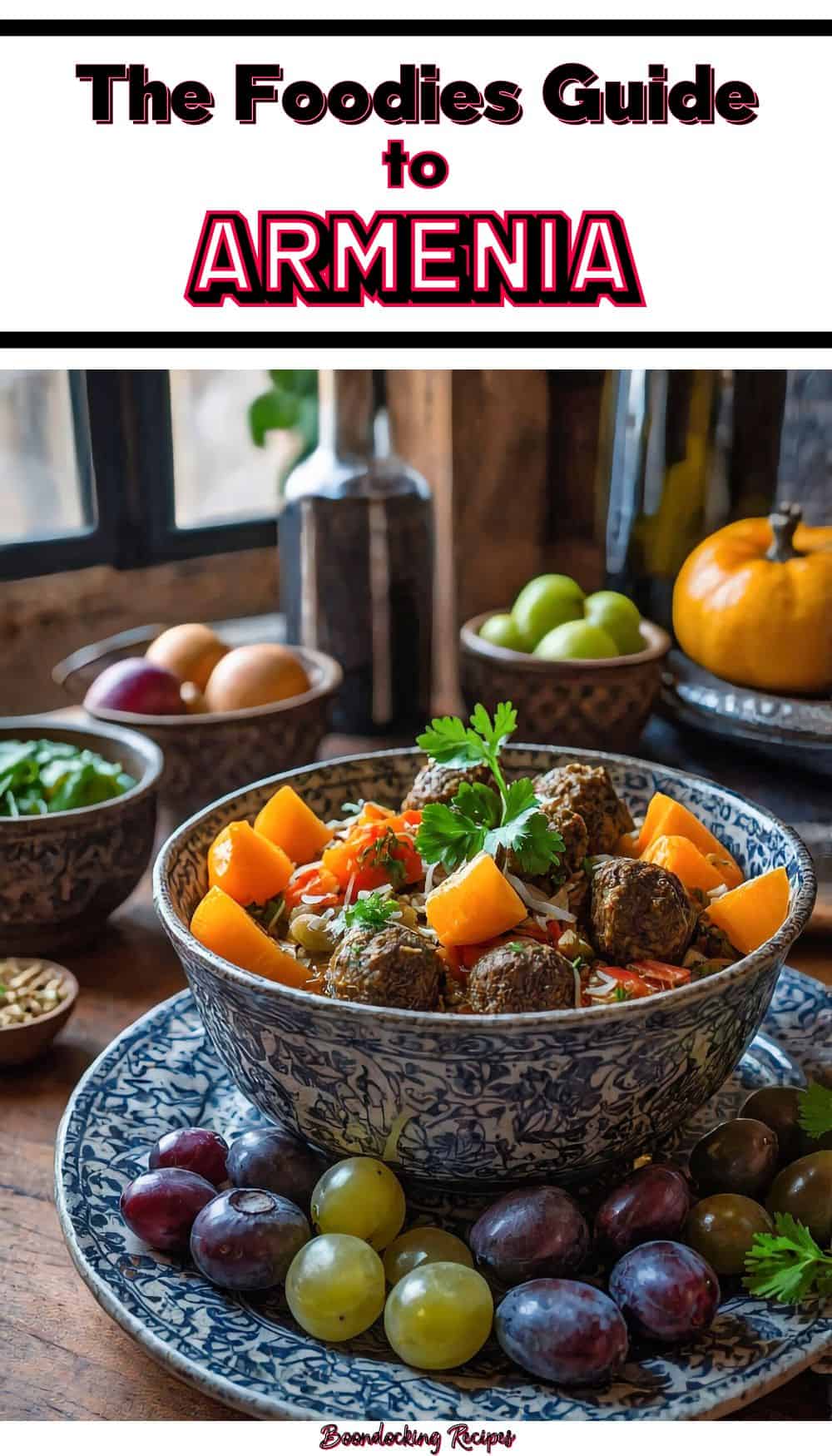
Foods to Try on Your Foodie Visit
Signature Dishes
Khash**: A hearty soup made from cow or sheep parts, traditionally consumed with garlic, bread, and vodka.
Dolma**: Grape leaves stuffed with rice and herbs—every family has its own recipe!
Lavas**: Thin flatbreads baked in a tonir, often served warm with cheese or herbs.
Ghapama**: A festive dish of pumpkin filled with rice, dried fruits, and nuts; a must-try during special occasions.
Sweet Treats
Gata**: A sweet pastry with a soft, flaky exterior, filled with sugar and nuts, perfect for dessert lovers.
End Of the Meal Summation
Culinary Conclusion
With its storied paths in culinary history, Armenia offers a delightful experience for any foodie travel lover. Each bite reveals a connection to the country’s heritage and the warmth of its people.
Discovering More
The journey through Armenia’s food scene is endless. It invites continual exploration — every market, every restaurant, tells a new story waiting to be tasted.
Your Foodie Adventure Awaits
So pack your bags and head to Armenia! Your taste buds are in for an extraordinary adventure filled with flavor, history, and warmth. Happy eating!
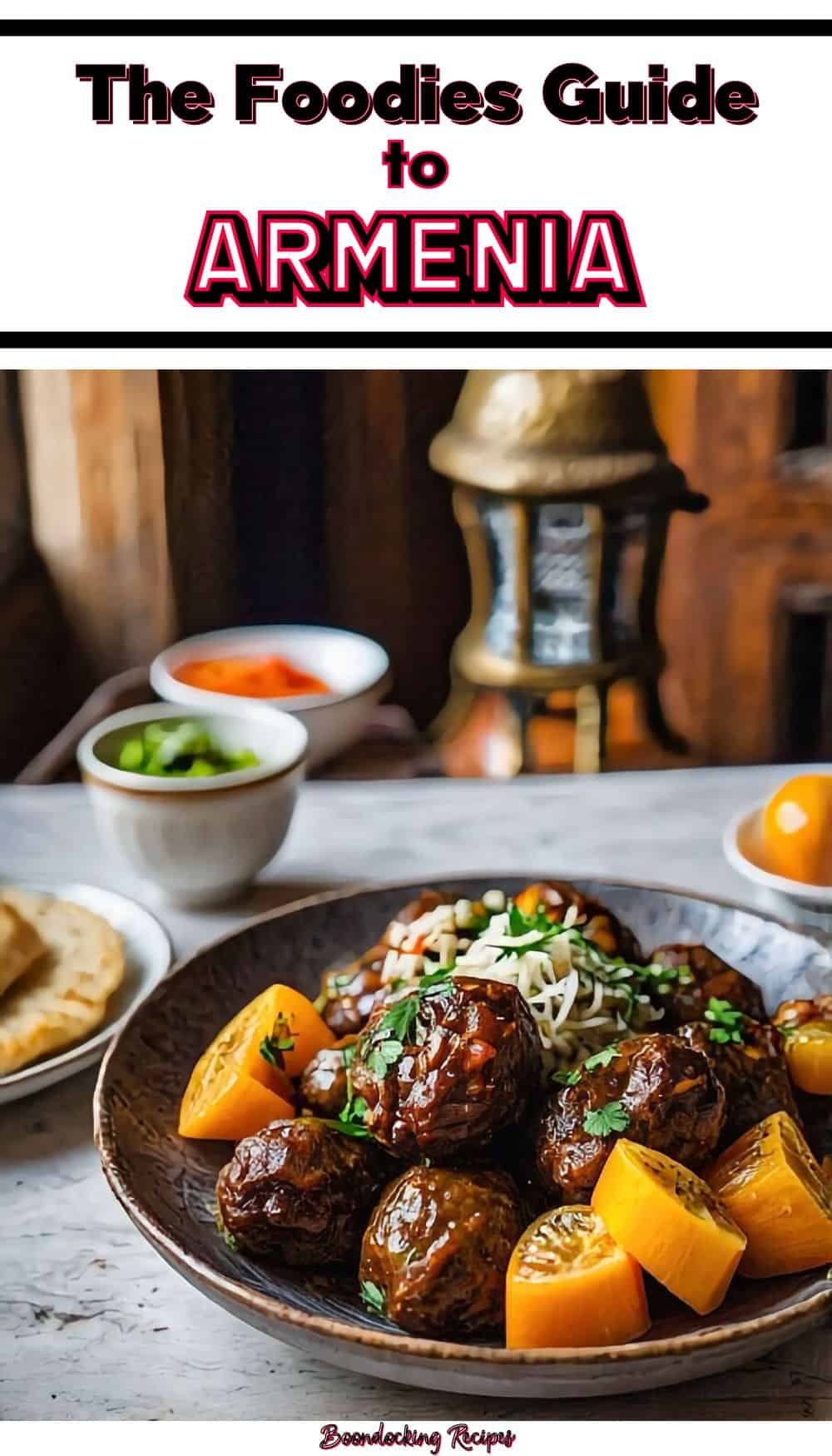
History of the Country Name
The history of Armenia’s name is a captivating journey into the fabric of its identity. When I first explored this beautiful country, I realized that the name “Armenia” reflects its rich cultural heritage and ancient origins. It invokes images of the lush landscapes and vibrant traditions that make Armenia a unique destination. This section is about understanding the origin and evolution of the name, much like unearthing layers of a long-forgotten story.
Origin of “Armenia”
One of the most intriguing aspects of my trip was learning about the name “Armenia” itself. Derived from the ancient kingdom of Urartu, which existed over 2,500 years ago, the name has roots that trace back to early civilizations. It originally referred to a region that spanned parts of present-day Armenia, Turkey, and Iran. This transformation of names symbolizes how places evolve along with their peoples and cultures.
One cannot overlook how languages contribute to the legacy of a name. The Greek historians were instrumental in shaping what we now recognize as “Armenia.” They used the term “Armenios” to denote the people living in this majestic region. Such historic naming not only reflects geography but also the bonds between the land and its inhabitants.
Historical Significance of the Name
History has a way of tightly weaving itself into the narrative of a name, and the name “Armenia” is no exception. The enduring significance of “Armenia” is not merely about a geographical reference; it symbolizes resilience and continuity through numerous empires that sought to define it. When I learned about these transitions, it felt like looking into a mirror reflecting centuries of dynamic storytelling.
Historical documents, artifacts, and the very names of cities often carry with them a profound weight that speaks volumes about the past. “Armenia” has become synonymous with concepts of survival, culture, and historic roots that persist even to this day, making it a cornerstone of the national identity.
Evolution Through Time
An exploration of Armenia’s name reveals how it has evolved through different eras and influences. Each period, from ancient Urartian rule to the classical age and beyond, has left a mark on how this name is perceived today. What struck me most was how each new civilization not only shaped the landscape but also the very label that people would recognize for generations.
This name didn’t simply exist in isolation; it was redefined by the actions and interactions of different cultures. As communities formed, merged, and sometimes clashed, they all contributed to the narrative wrapped around “Armenia,” ensuring that it would not fade into obscurity.
For instance, during the Byzantine Empire, the identity of Armenians began to crystallize in response to both internal dynamics and external pressures from powerful neighbors. These interactions played a crucial role in further embedding “Armenia” in the histories and hearts of its people.
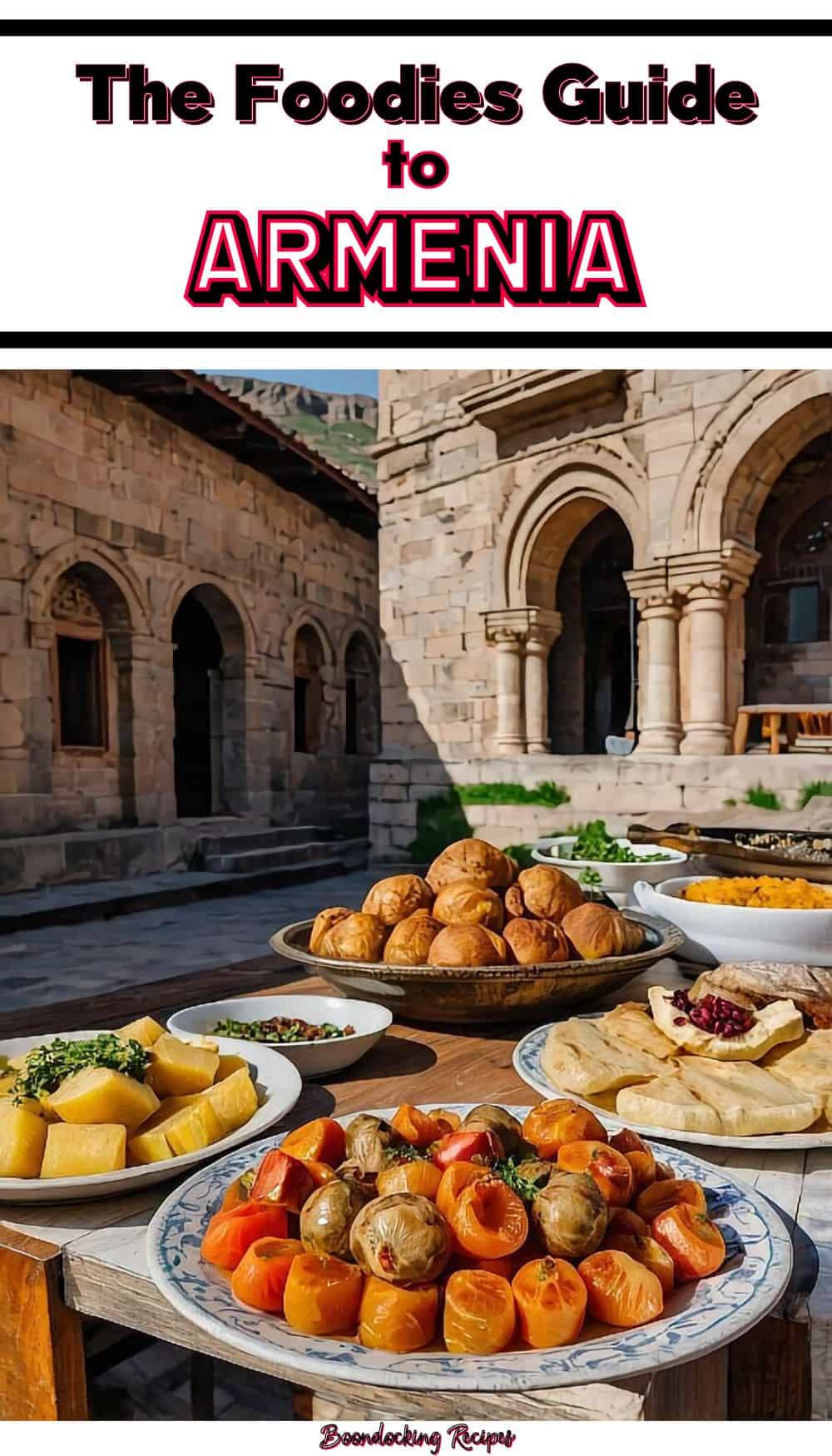
Location
While exploring the vibrant food scene in Armenia, I found that the country’s stunning geography plays a significant role in its culinary offerings. Nestled in the South Caucasus region, Armenia boasts a unique mix of mountains, valleys, and lakes, all of which contribute to its rich agricultural heritage.
The fertile land around the Ararat Valley is particularly known for its vineyards, while the mountainous terrain of the north ensures a diversity of ingredients that chefs expertly incorporate into traditional dishes.
Geographical Overview
On the eastern edge of Europe and the western edge of Asia, Armenia is located at the crossroads of the two continents. It’s a landlocked country, bordered by Turkey to the west, Georgia to the north, Azerbaijan to the east, and Iran to the south.
This strategic location not only influences its climate, making it ideal for a variety of crops, but also enriches its food culture with the flavors and culinary techniques of neighboring nations. I noticed how this geographical diversity enhances the offerings in Armenian cuisine, from hearty mountain dishes to vibrant agricultural fresh produce.
Neighboring Countries
Some may not realize how significant the surrounding countries are to Armenia’s culinary identity. Each neighbor brings its own flavors and traditions, infusing the cuisine with diversity. For example, Turkish and Persian influences are evident in many dishes, from grilled meats to fragrant rice preparations. This interplay of cultures truly fascinated me as I indulged in different meals throughout my foodie travels.
Overview of the neighboring countries reveals that this geographic positioning has historically been crucial not just for trade, but also for cultural exchange. The prevalence of spices, herbs, and cooking styles reflects the merging of Armenian flavors with those of Turkey, Iran, and Georgia. Each meal I enjoyed felt like a celebration of this historical tapestry, making every bite a journey through time and place.
Major Cities and Regions
Major cities and regions like Yerevan, Gyumri, and Dilijan offer unique culinary experiences that showcase local ingredients and traditions.
Yerevan, the capital city, is a hub for food enthusiasts, with bustling markets and a growing number of restaurants that emphasize farm-to-table concepts, allowing you to taste the essence of Armenian produce. Gyumri’s historical backdrop pairs beautifully with its rustic dining choices, while Dilijan’s lush greenery lends itself to fresh herbs and wild greens featured in various dishes.
For instance, Yerevan’s Republic Square acts as a culinary crossroads, where you can find everything from traditional Armenian barbecue to modern interpretations of classic recipes. The contrast between ancient cities and fresh culinary scenes made my experience unforgettable, and I highly recommend visiting these vibrant areas to embrace the Armenian food culture fully.
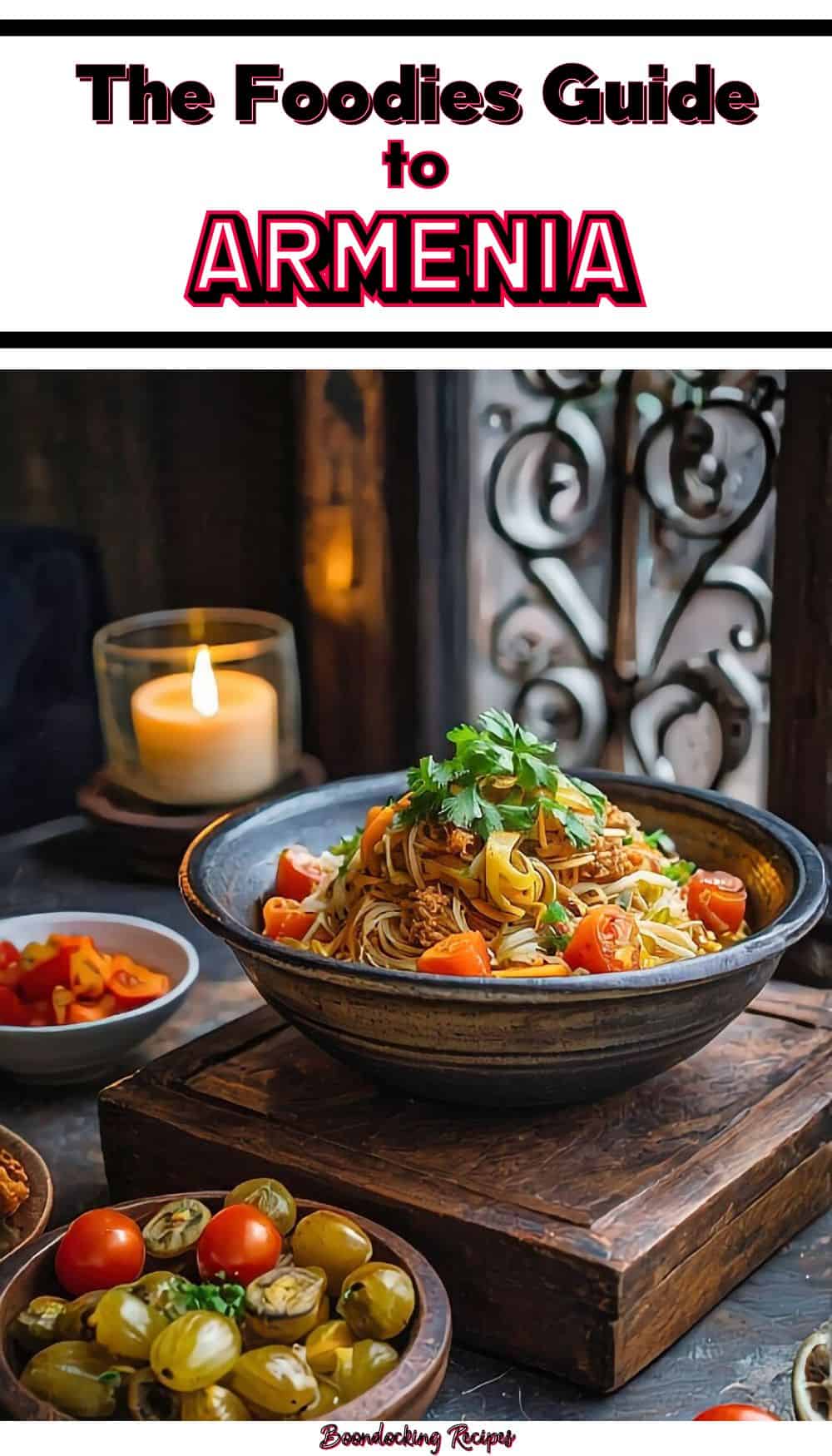
Brief History
Many people don’t realize that Armenia is home to one of the oldest civilizations in the world. Its rich tapestry of history is woven through the rise and fall of ancient kingdoms, the impact of neighboring empires, and its resilient spirit to maintain cultural identity. In this section, I’ll take you through the fascinating timeline of Armenia’s culinary heritage, showing how the flavors of this small nation have been shaped over millennia.
Ancient Civilization and Kingdoms
Now, let’s explore that ancient past. Armenia’s historical roots can be traced back to the Kingdom of Urartu, which flourished around the 9th century BC. Archeological findings reveal that the ancient Armenians were not only skilled farmers and horticulturists but also excelled in agriculture, making wine, and producing various fermented foods. Grapes played a vital role in their diet, paving the way for the world-famous Armenian brandy we enjoy today.
As I explored local markets, the remnants of these ancient practices felt palpable among the vendors selling homemade lavash and fresh fruits. It’s incredible to think how these traditional recipes have survived thousands of years while still resonating in the hearts of today’s Armenian people.
Influences of Conquerors
While immersing myself in Armenian culture, I couldn’t help but notice how the patterns of conquest have impacted the flavor landscape. Over centuries, Armenia experienced invasions and rule from various empires, including the Persians, Romans, and Ottomans. Each conqueror left a mark on the cuisine, introducing spices, cooking techniques, and ingredients that gradually merged with local traditions.
Ancient records reveal that the Persian influence brought in a taste for saffron and herbs, while the Ottomans introduced a plethora of pastries and coffee culture. Each layer of influence has contributed to a uniquely Armenian food experience—an eclectic mix that defines their culinary identity today.
Modern Historical Context
Historical events such as the Armenian Genocide in the early 20th century spurred significant changes in the country’s demographics and culinary practices. Despite adversity, the Armenian community around the world fervently preserved traditional recipes and flavors. During my time there, the resurgence of interest in authentic Armenian cuisine was palpable, often celebrated through food festivals and cooking classes.
With the modernization of cities and the influence of globalization, you can also find creative twists on traditional recipes that appeal to younger generations. The spirit of innovative chefs embracing old recipes while fusing international styles presents an exciting new chapter in Armenia’s culinary narrative.

Culture
Now that I’ve explored Armenia’s vibrant foodie travel scene, I’ve come to appreciate how deeply the country’s culture is woven into its culinary traditions. Culture in Armenia isn’t just about food; it’s a celebration of life, heritage, and a collective identity that flows through their arts, festivals, and social customs. From the colorful tapestries to the lively public celebrations, every facet of Armenian culture tells a story that enhances your culinary experience.
Traditional Arts and Crafts
To truly understand Armenia’s culture, I found that the traditional arts and crafts are necessary elements. During my foodie travels, I stumbled upon beautifully woven rugs and intricate pottery that are not just objects but pieces of history. Each art piece showcases the skills handed down through generations, often getting their inspiration from local landscapes and religious symbolism.
If you’re wandering through Yerevan’s vibrant markets, keep an eye out for handmade goods that make perfect souvenirs while acting as a slice of Armenian artistry.
To add to the experience, visiting local workshops where artisans share their techniques can be incredibly rewarding. The interaction with craftsmen and women offers insights into their dedication and passion, as they create stunning pieces that celebrate their culture while also enhancing your understanding of Armenian heritage.
Festivals and Celebrations
Crafts play an necessary role in Armenia’s festivals, contributing to the rich tapestry of communal life. The country celebrates numerous festivals that not only highlight its agricultural heritage but also showcase local cuisine, music, and dance. Events like the Gata (a traditional sweet bread) Festival in the town of Ararat introduce visitors to mouthwatering Armenian treats while allowing you to indulge in the local folk traditions.
Festivals are vibrant spectacles, transforming towns into lively hubs filled with laughter and music. During the Vardavar splash festival, for example, locals and tourists alike drench each other in water, symbolizing the cleansing of souls and the arrival of summer. This joyful interaction brings people together over shared joy and delicious Armenian dishes like khorovats (barbecued meat), enhancing the sense of community.
Language and Religion
Language is a window into the heart of Armenian culture. The unique Armenian alphabet, created by Mesrop Mashtots in the 5th century, is just one of the many fascinating facets of the language that I found during my visit. Through phrases and poetry, you’ll discover an intricate connection to the country’s history and traditions, making it even more special when you engage with locals.
Traditional practices in Armenia are deeply influenced by religion, predominantly the Armenian Apostolic Church. The church’s presence is felt everywhere, from the stunning architecture of ancient monasteries perched on mountainsides to the ritualistic foods served during specific holidays. This blend of language and religion shapes social interactions, making foodie travelers like you feel even more connected to the country’s rich cultural narrative.
Traditional Armenian customs often merge religious significance with daily life. For instance, certain foods are specifically prepared during holy days and special occasions, creating a bridge between spiritual and culinary experiences. By exploring the intersections of language and religion, you’ll gain a more profound appreciation for the role they play in Armenia’s culinary identity.

Food Influences and Roots
Not only did I fall in love with Armenia’s breathtaking landscapes, but I was also captivated by the rich tapestry of culinary influences that have shaped its food culture. As I dug deeper into my culinary journey in Armenia, I discovered that the roots of Armenian food run much deeper than just flavor; they encapsulate history, tradition, and the very essence of the people. Each dish tells a story of the land, the seasons, and the rituals that revolve around food, creating a unique experience that goes beyond mere nourishment.
Historical Agricultural Practices
Even in modern times, the echoes of ancient agricultural methods can be felt throughout Armenia’s rural landscape. The fertile soil of the Ararat Valley yields a variety of fruits and vegetables, providing the foundation for much of the country’s cuisine. Ancient irrigation techniques developed by the Armenians continue to be used today, allowing for the cultivation of famous crops like apricots and grapes. I found it fascinating to see how these historical practices have been lovingly passed down through generations, creating a legacy that is still very much alive.
Furthermore, I learned that Armenia is one of the oldest wine-producing regions in the world, with evidence of winemaking dating back over 6,000 years. This deep connection to agriculture not only affects what families eat but also fosters a strong sense of pride in local produce, which is celebrated in homes, restaurants, and festivals alike. I couldn’t help but admire the connection that Armenians maintain with their land and its bounty.
Neighboring Culinary Influences
Little did I realize that Armenia’s food scene is also flavored by its neighboring countries and their culinary traditions. For instance, you can taste hints of Persian, Turkish, and Georgian flavors in various dishes. Each neighboring nation has left its mark on Armenian cuisine, blending spices and cooking methods in a delightful tapestry of flavors. As I explored local eateries, I noticed how common ingredients were transformed into unique recipes that tell a story of cultural exchange.
To me, the fusion of these culinary influences adds an exciting dimension to the experience of Armenia foodie travel. For example, I found dishes like dolma (stuffed grape leaves) or kebabs served in charming local variations that reflect a blend of Armenian heritage and neighboring flavors. This intermingling creates an inviting atmosphere that is not only about eating, but also about sharing stories and traditions over a meal.
Religious and Spiritual Factors
Little did I know that religion plays a significant role in Armenia’s food culture. Being the first nation to adopt Christianity as the state religion, the influence of religious traditions and beliefs can be observed in many aspects of daily life, particularly when it comes to food.
Religious festivities often revolve around specific meals, where certain dishes are prepared and shared among families and communities. For example, during Lent, many Armenians consume only vegetarian dishes, emphasizing the importance of simplicity and spirituality during this time.
- The tradition of bread-making is sacred; khorovats is often served during important family gatherings.
- Holidays like Easter feature special dishes like “moudz” (colorful decorated eggs) that symbolize rebirth and renewal.
- Food is often seen as a blessing, with tradition dictating that meals are shared in abundance.
Perceiving the interplay of religion and food in Armenia really deepened my appreciation for the meals I experienced during my foodie travels. Each dish not only satisfied the palate but also served as a vessel for cultural heritage and spiritual significance.
A rich tapestry of customs also exists around food preparation and consumption, often intertwined with local beliefs and spiritual practices. I was amazed to observe that even the act of sharing a meal becomes a sacred ritual, fostering harmony and unity among those gathered.
- Fasting periods are observed, prompting special meals to be prepared just before the fast begins.
- Family gatherings often showcase traditional dishes that reflect the family’s history and stories.
- Packing a meal for those in need is seen as an act of kindness, tightly woven into the fabric of Christian values.
Perceiving these deep-rooted connections truly opened my eyes to the importance of food in understanding the Armenian way of life, reminding me that each meal is a celebration of culture, family, and faith.
Cuisine and Cooking Methods
After immersing myself in the vibrant streets of Yerevan, I quickly discovered that Armenian cuisine is not just about taste; it’s a reflection of the rich culture and traditions that have thrived in this beautiful country for centuries. The flavors are bright, hearty, and made with the freshest ingredients. I was thrilled to learn about the unique cooking methods that have been passed down through generations, making each meal a true experience. From the spices used to the techniques employed, every aspect of Armenian cooking tells a story of its own.
Unique Ingredients and Spices
Cuisine in Armenia is characterized by its unique ingredients and spices that give each dish its distinctive flavor. Whether it’s the fragrant herbs like mint and tarragon or spices such as sumac and cinnamon, you’ll find that these elements play a crucial role in most recipes. One of my personal favorites was the use of lavash—a traditional Armenian flatbread that’s almost a staple at every meal. It’s often made fresh in a tandoor, giving it that delightful smokiness I craved!
The significance of ingredients in Armenian cuisine can’t be overstated. The use of locally-sourced produce is not only a necessity due to the country’s geography, but it also means that the flavors are incredibly fresh. I was amazed at how straightforward dishes like khorovats (grilled meats) or dolma (stuffed grape leaves) could taste so rich and mouthwatering. It’s clear that these unique ingredients are integral to what makes Armenian food truly stand out.
Traditional Cooking Techniques
Ingredients in Armenian cuisine are often prepared using traditional cooking techniques that have been honed over time. For example, one of the most notable methods I learned about is the art of slow-cooking stews. Armenian khash, for instance, is cooked overnight, allowing the flavors to develop beautifully. This patience and attention to detail reveal a profound appreciation for food that I found quite touching.
Plus, there’s something incredibly communal about the way meals are prepared in Armenia. Many families still use a traditional stone oven known as a tonir, where dishes like lavash and khorovats are made. Gatherings around the tonir not only create delicious meals but also foster a sense of community and tradition. It was heartwarming to witness these age-old practices that connect families through food.
Modern Interpretations
Techniques in Armenian cooking are evolving, and many chefs are now experimenting with modern interpretations of traditional dishes. I encountered several trendy restaurants in Yerevan that put a contemporary twist on classic recipes. Imagine tasting a deconstructed version of dolma, where the flavors and textures are reimagined in a whole new way. This fusion of old and new made my dining experience all the more exciting!
Modern Armenian chefs are also increasingly incorporating international influences while maintaining the essence of traditional cuisine. They are layering flavors, experimenting with presentation, and using innovative ingredients that achieve fantastic results. I found the blend of traditional comfort foods with modern aesthetics intriguing—a true representation of how Armenian food is adapting to the changing culinary landscape.
Modern interpretations of traditional dishes also allow for more dietary versatility. For example, you can find vegan versions of classic stews that still embrace the flavors of the spices and herbs I’m so fond of. This new approach makes Armenian cuisine accessible to a broader audience while retaining its authenticity, which is something I truly appreciated during my foodie travels!

Foods to Try on Your Visit
All food enthusiasts will find themselves in a paradise when they visit Armenia, a land fortified with history, culture, and breathtaking landscapes. The culinary scene here is a delightful reflection of its rich traditions, showcasing flavors that speak volumes about its past. I remember the first bite of dolma; the burst of warmth and spices made me feel more connected to Armenia’s heritage, bridging the gap between old and new. Whether exploring bustling markets or enjoying a quiet meal at an intimate restaurant, the diversity of Armenia’s cuisine ensures that there’s something for everyone.
Iconic Dishes
The must-try dishes in Armenia embody both simplicity and depth, inviting you to experience a culinary adventure. From khorovats, Armenian barbeque, to lavash, an imperative flatbread that accompanies most meals, each dish tells a story. I found the hearty flavor of khorovats thrilling; the smoky, grilled meat paired with fresh herbs painted a picture of sunny picnics and family gatherings.
Just as imperative is the dolma, grape leaves stuffed with rice and spices, which offers a delicious bite and a sense of history. I recall sitting at a family-owned restaurant, each bite bringing forth the taste of traditions woven into their recipes for generations. Don’t miss the opportunity to indulge in these iconic dishes that will make your Armenian foodie travel unforgettable.
Street Food Delights
You haven’t truly experienced Armenia until you’ve sampled its street food. The lively streets, filled with tantalizing aromas, beckon you to come and taste their quick yet nutritious offerings. One of the first things I tried was georgian-style khachapuri, a cheese-filled bread that’s perfect for grabbing on-the-go. Another street food gem is the spicy sujuk, a dried sausage that packs some serious flavor; it was an unexpected delight that I can’t help but recommend!
Delights await you at every corner, from sizzling skewers of meat to sweet pastries like baklava. The vibrant energy of street vendors serving up tasty treats is an experience in itself, serving as a reminder of the community spirit and love that goes into Armenian food culture.
Regional Specialties
Visit the various regions of Armenia, and you’ll discover a tapestry of dishes unique to each area. For example, in the mountainous regions, dishes often feature more hearty ingredients to withstand the colder climate. One of my personal favorite local specialties was the barley pilaf, known as “ghapama,” which is filled with autumnal vegetables and spices so fragrant that it drew me in from afar.
Regional dishes vary not only in ingredients but also in preparation and presentation—each telling a story as old as the land itself. I found that the more I explored, the more layers of flavor and culture I uncovered, making every meal in Armenia a delightful surprise.
Regional dishes often highlight local produce and traditional cooking methods, making each bite not just a taste, but a journey through Armenia’s rich agricultural landscape.
Types of Armenian Food
Despite being a small country, Armenia boasts a rich and diverse culinary tapestry that tells the story of its heritage and culture. As I researchd into the Armenian foodie travel experience, I quickly discovered that Armenian food isn’t just about satisfying hunger; it’s about creating memories and sharing stories. From vibrant appetizers to hearty main courses, and delightful desserts, the flavors of Armenia left a lasting impression on my palate. Here’s what I learned about the different types of Armenian food you should explore on your journey!
| Type of Food | Description |
|---|---|
| Appetizers and Mezes | Small dishes perfect for sharing and enjoying flavors before the main meal. |
| Main Courses | Hearty and filling dishes that often feature meat, grains, and fresh vegetables. |
| Desserts and Sweets | Sweet indulgences that highlight local ingredients and traditions. |
| Beverages | A variety of drinks, including traditional wines and herbal teas. |
| Street Food | Quick bites available at local stalls, showcasing everyday Armenian flavors. |
Appetizers and Mezes
You can’t truly experience Armenian cuisine without starting with a selection of appetizers and mezes. These small dishes are colorful and bursting with freshness. For instance, I had a delightful plate of tabbouleh made with parsley, tomato, and bulgur that was both refreshing and full of zest. Another yummy option was mutabal, a smoky blend of eggplant complemented by tahini and olive oil. These dishes are often enjoyed with lavash, a traditional Armenian flatbread that you can’t afford to miss.
But don’t stop at just one! You can sample an assortment of mezes that may include kebabs, dolma (stuffed grape leaves), and a variety of cheeses. Each bite offers a glimpse into the rich traditions and communal dining culture of Armenia. For a more in-depth look at how chefs are embracing these culinary roots, check out In Armenia, Chefs and Restaurateurs Are Putting Heritage ….
Main Courses
To explore the heart of Armenian cuisine, you have to try its main courses, which are often grand and fulfilling. One of my favorite meals was khash, a traditional dish made from boiled cow’s feet served with garlic and fresh herbs. It’s hearty and perfect for the colder months, serving as a wonderful comfort food. Another must-try is lula kebab, spiced ground meat shaped around a skewer and grilled to perfection.
Plus, it’s important to note that Armenian dishes often have a depth of flavor that comes from the combination of local herbs and spices. The use of saffron, allspice, and coriander adds a unique twist to familiar ingredients. Don’t forget to sample a dish of dzhash—a flavorful stew that usually combines lamb and vegetables, encapsulating the essence of comfort in Armenian food culture.
Desserts and Sweets
You absolutely cannot leave Armenia without indulging in some desserts and sweets. I was particularly enchanted by gata, a sweet bread filled with an aromatic mixture of sugar, butter, and vanilla, which is traditionally enjoyed during celebrations. The delicate texture and sweet aroma made it a perfect ending to any meal.
The country also offers an array of pastries filled with nuts, dried fruits, and honey, like kyurab, a type of cookie that perfectly complements tea. You’ll find that desserts in Armenia are often a celebration of local produce and desserts often have a story tied to the region they hail from. If you love sweets as much as I do, then prepare for a delightful journey!
The Armenian culinary scene is vibrant, and as you explore the types of Armenian food, you’re sure to find favorites that resonate with your taste buds. Assume that every meal is an opportunity for a rich experience, connecting you to the heart of this beautiful heritage.

Dining Etiquette and Customs
Once again, I’d like to share some delightful discoveries from my recent adventure in Armenia. One aspect of the trip that stood out to me was the unique dining etiquette and customs that accompany meals in this beautiful country. Whether you’re invited to share a meal at a family home or dining at a local restaurant, understanding these traditions can enhance your experience and help you connect with the Armenian people in a deeper way.
Traditional Dining Practices
An integral part of the Armenian culture is its hospitality, which is reflected in their dining practices. When you enter someone’s home, you may be greeted with an abundance of food. Don’t be surprised if your host insists you have “one more” glass of wine or a second helping of khorovats (grilled meats), as this emphasis on generosity is a sign of respect and affection. Meals are usually enjoyed at a leisurely pace, allowing everyone to savor the flavors and engage in heartfelt conversations. The tradition of sharing food fosters a sense of community and togetherness.
Another interesting point is that Armenians have a custom called “khnocar” during meals, where the head of the family takes the first bites of food to signify that it is safe for everyone else to eat. This practice reinforces the connections between family members and shows the importance placed on shared meals in Armenian culture.
Table Manners and Greetings
There’s a warm and friendly atmosphere that permeates dining experiences in Armenia. When greeting your host or fellow diners, a polite smile and handshake are customary. Saying “Barev dzez” (Hello) is a great way to start off on the right foot with locals. Once seated, it’s important to wait for the host to begin the meal. They may offer a toast, which you should always participate in, raising your glass and making eye contact with others.
Dining can be a vibrant social event, and sharing stories while enjoying the delicious food is central to the experience. Keep in mind, it’s customary to try all the dishes offered to you, as leaving food on your plate may be seen as impolite. So, be prepared to eat well and engage in lively conversation!
Tipping and Payment
Dining in Armenia also comes with its own set of practices around tipping and payment. Tipping is expected in restaurants, typically around 10% of the total bill if service is good. However, in more traditional settings, tips may be given directly to the staff instead of added to the bill.
Additionally, many restaurants don’t accept credit cards, especially in smaller towns, so be sure to carry cash. It’s also common to split the bill among friends when dining out, which adds to the communal dining experience that I found to be a memorable aspect of Armenian culture.
For instance, I found myself at a cozy little eatery in Yerevan, where my friends and I decided to share several dishes. We pooled our resources to cover the bill, expressing our appreciation for the meal and the friendly service we received. The laughter and camaraderie, paired with exceptional food, created a dining experience I cherished.
Tips for Foodies Visiting Armenia
Keep these vital tips in mind to make the most of your food journey in Armenia. As a food lover, I can tell you that every dish in this enchanting country has a story to tell. Knowing a bit about local customs and dining etiquette can elevate your experience significantly. Here are some tips to help you navigate your foodie travel adventure:
- Try to learn a few basic Armenian phrases; locals appreciate it!
- Be prepared for generous portions; sharing is a communal experience.
- Don’t hesitate to ask for recommendations from locals or restaurant staff.
- Keep an open mind; the flavor combinations may surprise you.
- Explore street food as some of the best flavors come from the stalls!
The culinary landscape of Armenia is truly vibrant, and understanding the best times to visit can enhance your food journey significantly.
Best Times to Visit for Food
Best of all, the best time to visit Armenia for food is during the late spring to early fall. Spring brings an abundance of fresh produce, and the vibrant colors of the markets are simply intoxicating. The local farmers’ markets burst with seasonal delights like strawberries, cherries, and greens, which make for fantastic ingredients in many traditional dishes.
As the summer months heat up, the grape harvest kicks off, leading to an array of wine festivals. The lively atmosphere and rich flavors enhance your culinary experience and allow you to mingle with locals while tasting their homemade wines. If you’re a true foodie travel lover, you won’t want to miss this seasonal bounty!
Recommended Restaurants and Eateries
Little did I know that some of the best meals of my life would be in unassuming taverns and bustling cafes. One standout is “Artbridge,” located in Yerevan. This place serves up exquisite modern takes on traditional Armenian dishes. You simply must order their signature khorovats (grilled meat) served with fresh lavash and a local salad.
Visit also the “Tavern Yerevan,” where the ambiance is as fantastic as the food. The rustic decor and traditional music transport you back in time, and the menu reflects the heart of Armenian cuisine. The dumplings here, or “manti,” are a must-try for fans of hearty and comforting dishes. Make sure to ask your server for dessert recommendations—they won’t disappoint!
Food Tours and Experiences
Food tours can really deepen your understanding of Armenian cuisine, and I wholeheartedly recommend this immersive experience. Food tours often showcase a mix of eating and learning, guiding you through the culinary streets of Armenia. You’ll discover hidden gems—family-owned eateries that serve food with love and tradition.
For instance, I joined a food tour that took me through Yerevan’s vibrant market scene. We sampled fresh lavash straight from the oven, and I learned how important this staple is in Armenian culture. Our guide shared fascinating stories behind each dish, and I walked away with not only a full belly but also added knowledge about the cultural significance of what I was eating.
As you plan your culinary adventure in Armenia, focus on these tips as a guide to truly enjoy the local flavors, vibrant markets, and delightful dining experiences.
# Step-by-Step Guide to Preparing Armenian Dishes
To truly appreciate the rich culinary landscape of Armenia, it’s important to understand how to prepare its distinctive dishes. This guide will offer you a step-by-step approach to follow, showcasing important ingredients, cooking techniques, and recipe examples. With a little practice, you’ll be serving up delicious Armenian food in no time!
| Step | Description |
|---|---|
| 1 | Gather your important ingredients. |
| 2 | Learn cooking techniques unique to Armenian cuisine. |
| 3 | Follow specific recipes for traditional Armenian dishes. |
Essential Ingredients
One of the best parts about Armenian food is its reliance on fresh, high-quality ingredients. Staples such as lamb, rice, and various vegetables play a vital role in creating authentic flavors. You’ll often find that spices like sumac and coriander lend a unique taste to the dishes. Furthermore, herbs like parsley and dill can elevate your meals significantly, adding both flavor and color.
I was amazed to discover how simple yet flavorful many Armenian dishes can be, all thanks to a handful of important ingredients. Fresh produce, robust meats, and aromatic spices converge to create a sensory experience unlike any other. As you experiment with these ingredients, don’t be afraid to adjust them to suit your personal taste!
Cooking Techniques
There’s something truly special about the cooking techniques used in Armenian cuisine. Traditional methods like grilling, slow-cooking, and baking help develop deep flavors that are characteristic of the region. For example, khorovats, or Armenian barbecue, involves marinating meats in spices and grilling them on skewers to create smoky, mouthwatering dishes.
Cooking also involves a lot of rustic charm, such as using clay pots for slow-cooked stews. Those pots not only retain heat exceptionally well, but they also infuse dishes with an earthy flavor that you can’t replicate in regular cookware. I love the idea that each technique tells a story about the land and its people.
Recipe Examples
Any attempt to try Armenian cuisine wouldn’t be complete without submerging into some authentic recipes. Take the time-honored dish of dolma, which consists of grape leaves stuffed with a savory mix of rice, herbs, and meats. Another favorite is lavash, a traditional flatbread that’s perfect for wrapping around grilled meats or accompanying a meal.
If you’re looking for something sweeter, don’t overlook baklava! This flaky pastry filled with nuts and honey is a dessert that shines in Armenian festivals and gatherings. I found that these dishes are not only delicious but also have a way of bringing people together—something that resonates deeply in Armenian culture.
With these foundational steps, you’ll find yourself well on your way to creating memorable Armenian meals, perfect for impressing your friends or simply indulging in the rich heritage of Armenia. So gather your ingredients, polish your cooking techniques, and don’t hesitate to explore various recipes to get a real taste of this unique cuisine.
Factors to Consider When Exploring Armenian Cuisine
For anyone initiateing on an Armenia foodie travel adventure, there are several factors to keep in mind that will enhance your culinary experience. The rich tapestry of Armenian cuisine is woven with unique flavors, cultural significance, and regional specialties. Understanding these facets will not only enrich your experience, but it will also allow you to appreciate the diversity that each dish presents. Here are some important considerations:
- Be aware of local customs related to dining etiquette.
- Consider the influence of Armenia’s geographic location on its food scene.
- Familiarize yourself with traditional Armenian ingredients and cooking techniques.
Perceiving the nuances of Armenia’s culinary landscape can transform your foodie travels into a delicious journey.
Dietary Restrictions
The diversity of Armenian cuisine means there’s generally something for everyone, but it’s wise to be aware of dietary restrictions. Some dishes may be heavily seasoned or contain ingredients like nuts, dairy, or gluten. When visiting local restaurants, don’t hesitate to inform the staff about any dietary needs you may have; they are typically more than willing to accommodate you. You’ll often find that vegetarian and vegan options are increasingly common due to the natural abundance of fresh vegetables and grains.
Additionally, if you have other specific dietary needs, it’s always a good idea to do a bit of research before your trip. Resources like Food and wine tours in Armenia – Evaneos.com can provide insight into places that cater to various diets.
Popularity of Foods Across Regions
Factors influencing the popularity of foods in Armenia can often be traced back to the geographical and cultural characteristics of each region. For example, the mountainous regions tend to favor heartier dishes, while the more fertile areas produce lighter fare with an abundance of vegetables and herbs. Additionally, the cultural exchanges with neighboring countries also have an influence, leading to a delightful mix of tastes and presentations.
This geographical disparity can be seen in regional specialties that are not just limited to main dishes but also extend to side dishes, appetizers, and desserts. Take the chance while foodie traveling to explore the menus in different locales; you may discover unique variations of classic Armenian dishes that are specific to that region.
Price Range of Dining Options
An important consideration when exploring into Armenia’s culinary scene is the price range of dining options available. From budget-friendly street food stalls to upscale dining establishments, there truly is something for every wallet. Throughout Yerevan and rural towns alike, you can savor traditional dishes without breaking the bank, especially if you’re dining at local cafés or eateries. On my trip, I was thrilled to discover delightful meals for under $10!
Cuisine costs can also vary greatly depending on where you are eating. Fine dining or food experiences that involve traditional methods and local ingredients may command higher prices, while casual dining remains wallet-friendly. If you keep an eye out for local specials or menus, you can enjoy great meals and experiences without feeling guilty about your budget.
Pros and Cons of Food Experiences in Armenia
| Pros | Cons |
|---|---|
| Rich Culinary Traditions | Limited Global Influence |
| Fresh, Organic Ingredients | Occasional Language Barrier |
| Welcoming Local Culture | Limited Variety in International Cuisine |
| Unique Flavor Profiles | Price Variations in Urban vs Rural Areas |
| Numerous Traditional Dishes | Underdeveloped Food Tourism Infrastructure |
| Health Benefits of Local Foods | Inconsistent Quality in Some Venues |
Pros: Rich Culinary Traditions
One of the things that captivated me during my Armenia foodie travel was the rich culinary traditions that permeate every meal. It’s truly fascinating how much history is reflected in the dishes. You can sample an infinite number of preparations that have been passed down through generations, each with its unique story and significance. From fragrant herbs to handmade breads, Armenia’s cuisine offers a delightful journey through time and culture.
Another aspect of Armenia’s culinary prowess is the emphasis on communal dining. Shared meals strengthen bonds and create a warm atmosphere where you can enjoy both the cuisine and the company. I loved watching locals gather around tables laden with colorful dishes, experiencing the essence of Armenian hospitality while savoring flavorful foods that nourish both body and soul.
Cons: Limited Global Influence
With so many incredible food experiences available, one downside I encountered was the limited global influence in Armenian cuisine. While I respect the dedication to traditional flavors, it can sometimes feel somewhat insular. If you’re expecting a vast array of international options, you might find yourself a little disappointed, especially in smaller towns.
Additionally, the influence of global culinary trends, like fusion cooking, hasn’t quite made its way into Armenia yet. This means that if you’re looking for adventurous meals or innovative culinary techniques, you might find your options limited. Authenticity is great, but sometimes a little variety serves to broaden our palates.
Armenia’s food scene, while rich in heritage, might not include that many global influences. You won’t find the array of international cuisines that you might come across in larger cities in neighboring countries. However, sometimes that lack of global presence can lead to a more authentic experience where you get to truly immerse yourself in Armenian culture.
Overall Experience
Pros of the food experiences in Armenia far outweigh any drawbacks. I cherished the chance to try traditional dishes filled with flavors unique to this ancient culture. It was enlightening to see how the ingredients were sourced and prepared, and to learn about the various culinary rituals that accompany meals. Ultimately, each dish is crafted with care, making every bite feel special—an affection that reflects the Armenian spirit.
Beyond the flavors and ingredients, the people I met throughout my foodie travels were some of the most welcoming. Sharing a meal with locals not only allowed me to indulge in their unique flavors but also connected me more deeply with their way of life. So, if you decide to initiate on your own Armenia foodie travel journey, expect an experience as enriching as it is delicious.
Influence from other countries may be minimal, but this allows you to experience something rare—a pure connection to a land steeped in centuries of culinary tradition. Every meal is an invitation to understand Armenia just a little more.
# Armenia Foodie Guide: A Delicious Journey Through the Ravishing Flavors of Armenia
Nestled at the crossroads of Europe and Asia, Armenia boasts a rich culinary tradition that reflects its history and vibrant culture. As someone who recently ventured into the heart of this beautiful country, I’m excited to share my experiences exploring the Armenian food scene.
From flavors that dance on your taste buds to heartwarming meals shared with locals, Armenia’s cuisine is truly a treasure trove for any foodie travel adventure seeker. This guide will examine into the history, influences, and unique foods to savor during your visit, leaving you with a deeper appreciation for the culinary heritage of Armenia. Get ready to launch on a mouthwatering journey as we uncover the best bites in this captivating country!
Summing Up Our Armenia Foodie Travel Adventure
Upon reflecting on my journey through Armenia’s culinary landscape, I realize that it’s not just the food that left a lasting impression but the warmth of the Armenian people sharing their heritage. Exploring flavors and recipes was an adventure that deepened my appreciation for their rich culture and history. I encourage you to examine into Armenia food travel; believe me, it’s a journey you won’t forget.
As you plan your trip, remember to savor every moment and every bite—we are not just tasting a dish; we are experiencing a story. From mouthwatering khorovats to sweet gata at the family table, relish each unique flavor and tradition that Armenia offers on this incredible foodie travel journey!
FAQ About Foodie Travel in Armenia
Q: What is the best time of year for foodie travel in Armenia?
A: The best time for foodie travel in Armenia is during the late spring (May to June) and early autumn (September to October). These periods offer mild weather and coincide with harvest season, allowing travelers to experience Armenia’s freshest local produce and traditional food festivals.
Q: What are must-try dishes during foodie travel in Armenia?
A: During foodie travel in Armenia, must-try dishes include *khorovats* (Armenian barbecue), *dolma* (stuffed grape leaves), *lavash* (traditional flatbread), *khash* (a hearty soup), and *gata* (a sweet pastry). Each dish offers a unique taste of Armenian culture and culinary traditions.
Q: Are there any foodie travel tours available in Armenia?
A: Yes, there are several foodie travel tours available in Armenia. These tours often include guided visits to local markets, cooking classes, wine tasting in the Areni region, and dining experiences at authentic Armenian restaurants, providing an immersive experience in Armenian cuisine.
Q: How does Armenia’s geography influence foodie travel experiences?
A: Armenia’s diverse geography, from fertile valleys to mountainous regions, greatly influences foodie travel experiences. The variety of landscapes results in a rich array of local ingredients, including fresh fruits, vegetables, herbs, and dairy products, which are integral to Armenian cuisine.
Q: What should I expect from a foodie travel experience in Armenia?
A: A foodie travel experience in Armenia typically includes tasting traditional dishes, visiting local markets, engaging in cooking workshops, and exploring the wine-making regions. Expect a journey rich in flavors, cultural insights, and hospitality from the local people.
Q: Can I find vegetarian or vegan options during foodie travel in Armenia?
A: Yes, you can find vegetarian and vegan options during foodie travel in Armenia. Many traditional Armenian dishes, such as *eetch* (a bulgur salad) and various *tolma* (stuffed vegetables), are naturally vegetarian or vegan. Additionally, Armenian cuisine features a wide variety of fresh fruits and vegetables.
Q: Is foodie travel in Armenia family-friendly?
A: Foodie travel in Armenia is family-friendly, with many activities suitable for all ages. Families can enjoy cooking classes, visit farms, and taste local honey and dairy products. Armenian hospitality ensures that children are welcomed and catered to in most dining establishments.
Q: How does Armenia’s history impact its foodie travel scene?
A: Armenia’s rich history, including influences from Persian, Ottoman, and Russian cuisines, greatly impacts its foodie travel scene. Travelers can taste dishes that reflect centuries of cultural exchange and adaptation, making Armenian cuisine a living history lesson on a plate.
Q: What are some popular foodie travel destinations within Armenia?
A: Popular foodie travel destinations within Armenia include Yerevan, the capital, known for its diverse dining options; the Areni wine region, famous for its vineyards; and the Lori province, where travelers can taste local dairy products and enjoy rural culinary traditions.
Q: Can I combine foodie travel with cultural experiences in Armenia?
A: Absolutely! Foodie travel in Armenia can be easily combined with cultural experiences. Many tours offer a mix of food tasting, visits to historical sites like monasteries, and participation in traditional festivals, providing a well-rounded experience of Armenian culture and cuisine.

